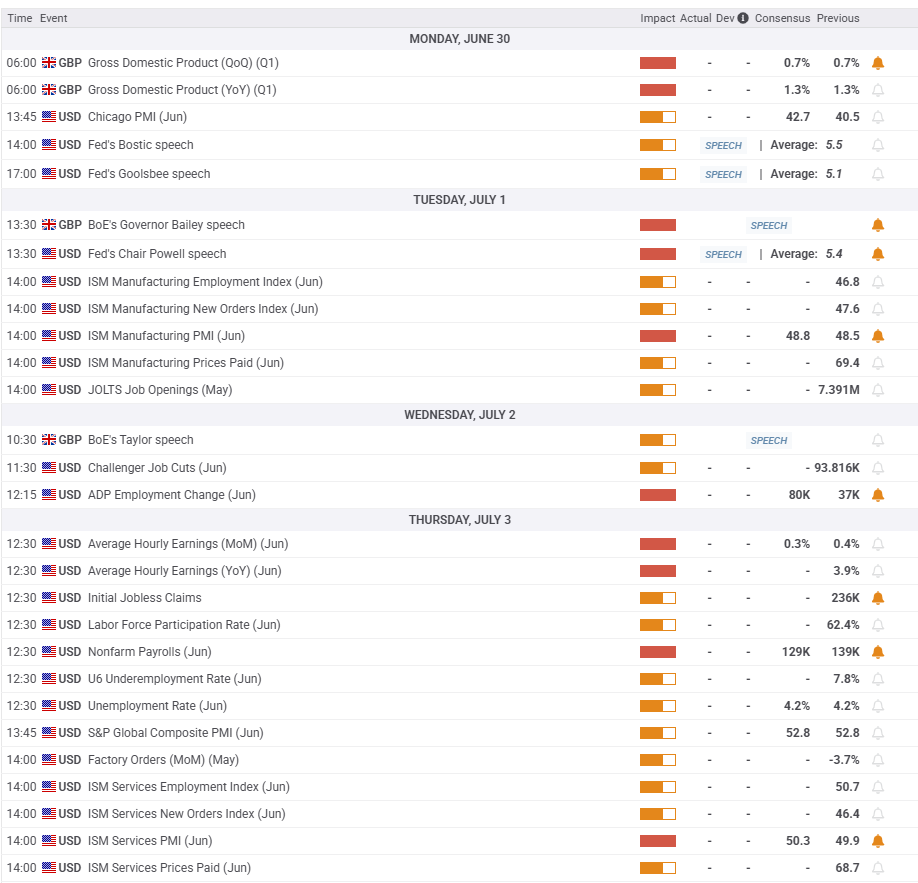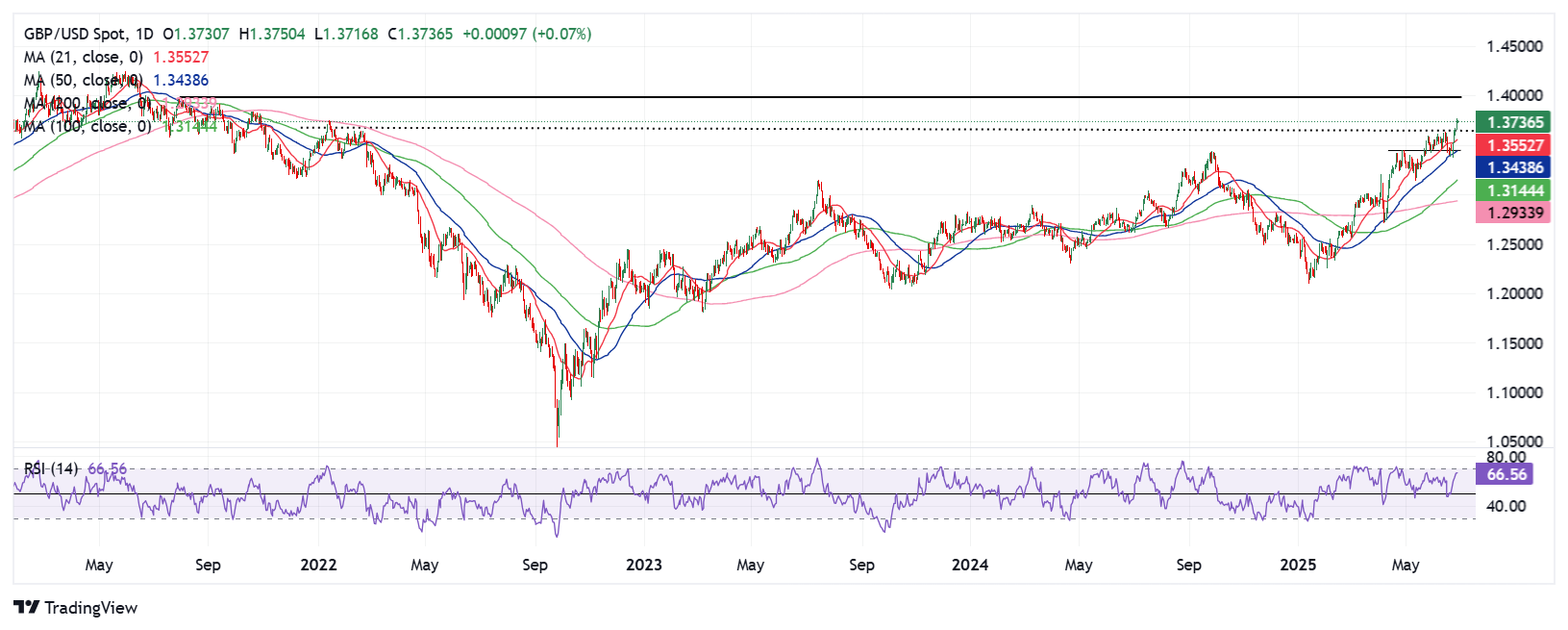
- The Pound Sterling rebounded firmly to hit over three-year highs against the US Dollar.
- GBP/USD traders await speeches from Powell and Bailey ahead of the US Nonfarm Payrolls.
- The daily technical setup suggests further upside for the GBP/USD pair.
The Pound Sterling (GBP) recovery gathered steam against the US Dollar (USD), driving the GBP/USD pair to the highest level since October 2021, above 1.3750.
Pound Sterling buyers remained in command
It was a clear win-win case for the higher-yielding Pound Sterling as the US Dollar gradually lost its safe-haven appeal amid yo-yo-ing sentiment surrounding the US Federal Reserve’s policy outlook.
Though the GBP/USD pair saw a bearish opening gap on Monday, it was quickly reversed as buyers jumped back with a bang.
The Pound Sterling was sold off at the weekly open as investors scurried for safety in the US Dollar after markets reacted negatively to the weekend news of the US military involvement in the Israel-Iran conflict.
Early Sunday, US President Donald Trump announced that the United States (US) carried out airstrikes on three of Iran’s most critical nuclear sites, Fordow, Natanz and Isfahan.
In response, Supreme Leader Ayatollah Khamenei warned that American involvement would bring “irreparable damage,” raising concerns that the Israel-Iran conflict would translate into a wider Middle East regional war.
However, the Greenback’s safe-haven appeal fizzled out, following the Iran-Israel ceasefire announcement by US President Donald Trump and later by Iranian Foreign Minister Abbas Araghchi late Monday.
Reviving expectations surrounding a Fed interest rate cut in July exerted additional downward pressure on US currency, helping the pair stage a solid turnaround.
These expectations were prompted by Fed Governor Michelle Bowman and her colleague Christopher Waller, who advocated the next rate cut as early as July.
Markets are currently pricing in a 21% chance of a July Fed rate cut, while for a September reduction, the odds stand at 75%, the CME Group’s FedWatch Tool showed.
On Tuesday, the Greenback briefly drew support from Fed Chair Powell’s testimony before the House Financial Committee, but the Middle East de-escalation overshadowed and continued to boost risk appetite.
Risk flows drove US stocks higher, diminishing the USD’s status as a safe haven.
Powell said he expects policymakers to stay on hold until they have better clarity on the impact tariffs will have on prices. “We’re just trying to be careful and cautious,” he noted.
The USD’s declines gathered strength, and it hit over three-year highs against its major currency rivals in the aftermath of US President Donald Trump’s fresh attack on the Federal Reserve’s (Fed) credibility.
Citing some sources, the Wall Street Journal (WSJ) reported early Thursday that President Trump is considering selecting and announcing a successor for Fed Chair Jerome Powell by September or October.
The unabated US Dollar selling drove the pair to three-and-a-half-year highs of 1.3771 on Thursday. However, USD buyers quickly returned at lower levels after a person familiar with the White House’s deliberations told Reuters on Thursday, “Trump has not decided on a replacement for Powell and a decision is not imminent.”
Moreover, hopes of US trade deals with the European Union (EU) and China before the July 9 deadline helped the US Dollar cut some of its weekly losses early Friday.
A WSJ report cited late Thursday that EU officials are weighing lowering tariffs on US imports to woo Trump.
Meanwhile, a White House official said that the US has reached an understanding with China on how to expedite rare earth shipments to the US. In the American session on Friday, the data published by the US Bureau of Economic Analysis showed that the core Personal Consumption Expenditures (PCE) Price Index, the Fed’s preferred gauge of inflation, rose 2.7% on a yearly basis in May. This reading came in above the market expectation and April’s increase of 2.6% and helped the USD limit its losses, making it difficult for GBP/USD to extend its rally heading into the weekend.
A Big week to watch out for
It’s a critical week, though holiday-shortened, filled with a flurry of high-impact economic data from the United States (US) and central banks’ talks.
The week begins with China’s official Manufacturing and Non-Manufacturing PMI readings on Monday, which could set the tone for markets, significantly impacting risk sentiment.
The US and the UK dockets are data-dry on Monday, and hence, the attention turns to Tuesday’s US JOLTS Job Openings Survey and the ISM Manufacturing PMI.
However, the main event risks that day would be the speeches from BoE Governor Bailey and Fed Chair Powell as they participate in a panel discussion titled “Policy panel” at the two-day European Central Bank (ECB) Forum on Central Banking, in Sintra.
These commentaries could overshadow the impact of the US data releases on Tuesday, stirring volatility around the USD, in turn, the GBP/USD pair.
Wednesday will feature the US ADP Employment Change report for June, followed by an action-packed American calendar on Thursday, as markets will observe Independence Day on Friday, July 4.
All eyes will remain on the US Nonfarm Payrolls data for June alongside the releases of the Jobless Claims, Trade Balance, and the ISM Services PMI data.
Markets will continue to monitor the developments on the trade front and geopolitical updates from the Middle East conflict.

GBP/USD: Technical Outlook

GBP/USD defended the critical 50-day Simple Moving Average (SMA) support, then at 1.3402, and surpassed two major resistance levels on its way to multi-month highs at 1.3771.
In the upcoming week, the pair remains poised for more upside as long as the 14-day Relative Strength Index (RSI) holds comfortable in the bullish territory.
The leading indicator currently sits just beneath the overbought zone, supporting the bullish bias.
If the RSI enters the overbought region above the 70 level, the pair could see a brief correction toward the previous resistance-turned-support of the February 2022 high at 1.3643.
The 21-day SMA at 1.3552 could challenge the bullish commitments if the pullback gains traction.
Additional declines will likely attack the 1.3445 demand zone, which is the confluence of the April 28 high and the 50-day SMA.
On the other hand, if the buying interest remains unabated, GBP/USD could take on the 1.3800 round level, above which the static resistance around 1.3875 will come into play.
Further north, buyers will target the July 30 high of 1.3983.
British Pound PRICE This year
The table below shows the percentage change of British Pound (GBP) against listed major currencies this year. British Pound was the strongest against the US Dollar.
| USD | EUR | GBP | JPY | CAD | AUD | NZD | CHF | |
|---|---|---|---|---|---|---|---|---|
| USD | -11.60% | -8.86% | -8.20% | -5.15% | -5.40% | -7.78% | -12.05% | |
| EUR | 11.60% | 3.07% | 3.86% | 7.29% | 6.93% | 4.32% | -0.51% | |
| GBP | 8.86% | -3.07% | 0.75% | 4.10% | 3.75% | 1.21% | -3.48% | |
| JPY | 8.20% | -3.86% | -0.75% | 3.35% | 3.06% | 0.49% | -4.13% | |
| CAD | 5.15% | -7.29% | -4.10% | -3.35% | -0.37% | -2.78% | -7.29% | |
| AUD | 5.40% | -6.93% | -3.75% | -3.06% | 0.37% | -2.44% | -6.96% | |
| NZD | 7.78% | -4.32% | -1.21% | -0.49% | 2.78% | 2.44% | -4.63% | |
| CHF | 12.05% | 0.51% | 3.48% | 4.13% | 7.29% | 6.96% | 4.63% |
The heat map shows percentage changes of major currencies against each other. The base currency is picked from the left column, while the quote currency is picked from the top row. For example, if you pick the British Pound from the left column and move along the horizontal line to the US Dollar, the percentage change displayed in the box will represent GBP (base)/USD (quote).
Information on these pages contains forward-looking statements that involve risks and uncertainties. Markets and instruments profiled on this page are for informational purposes only and should not in any way come across as a recommendation to buy or sell in these assets. You should do your own thorough research before making any investment decisions. FXStreet does not in any way guarantee that this information is free from mistakes, errors, or material misstatements. It also does not guarantee that this information is of a timely nature. Investing in Open Markets involves a great deal of risk, including the loss of all or a portion of your investment, as well as emotional distress. All risks, losses and costs associated with investing, including total loss of principal, are your responsibility. The views and opinions expressed in this article are those of the authors and do not necessarily reflect the official policy or position of FXStreet nor its advertisers. The author will not be held responsible for information that is found at the end of links posted on this page.
If not otherwise explicitly mentioned in the body of the article, at the time of writing, the author has no position in any stock mentioned in this article and no business relationship with any company mentioned. The author has not received compensation for writing this article, other than from FXStreet.
FXStreet and the author do not provide personalized recommendations. The author makes no representations as to the accuracy, completeness, or suitability of this information. FXStreet and the author will not be liable for any errors, omissions or any losses, injuries or damages arising from this information and its display or use. Errors and omissions excepted.
The author and FXStreet are not registered investment advisors and nothing in this article is intended to be investment advice.








